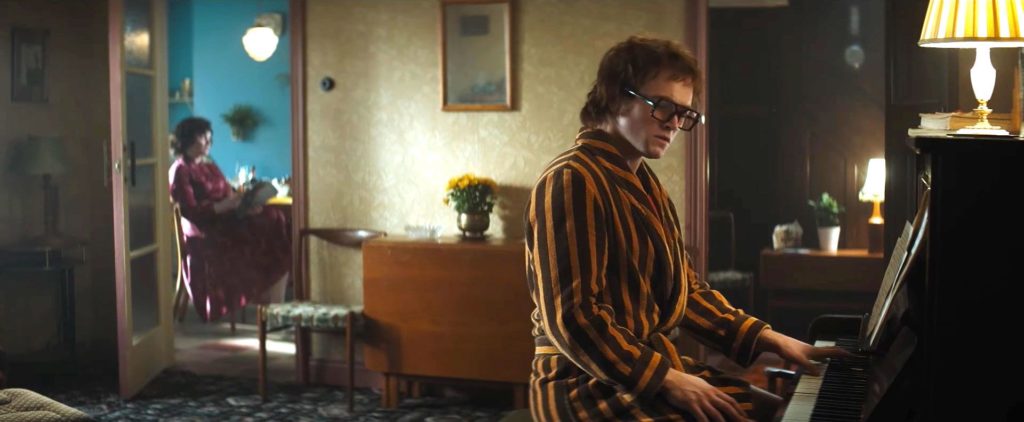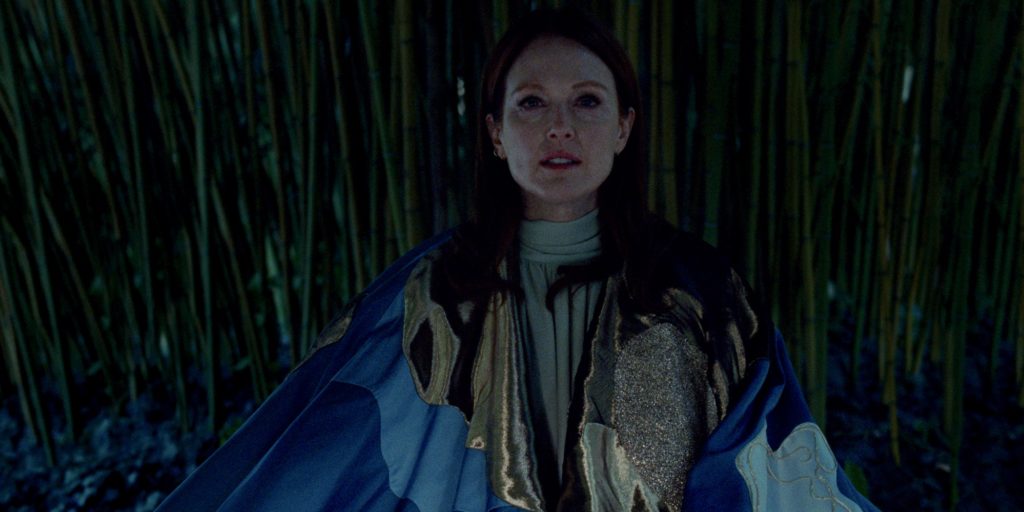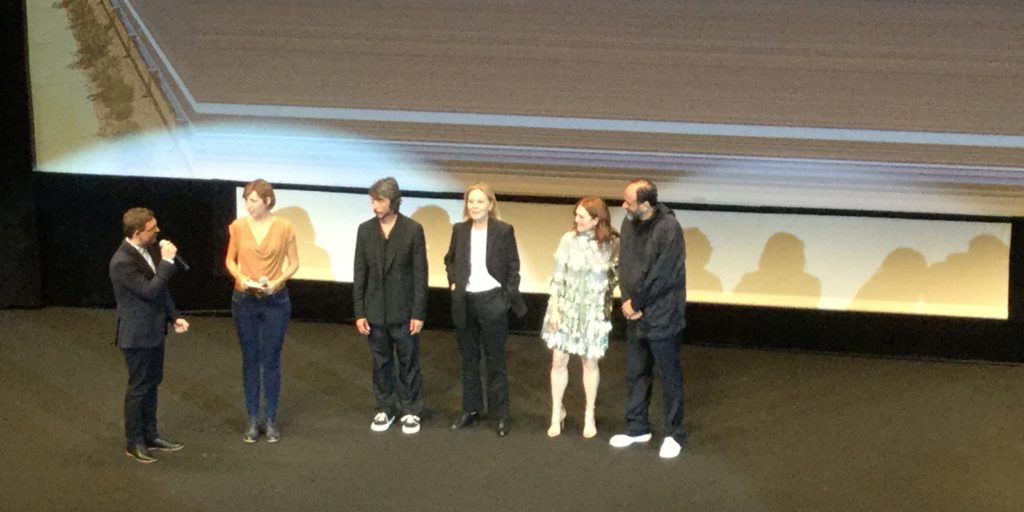As I lumbered out of bed at 6:00 in the morning into an overcast day on the croisette on my second day of the festival, I had little idea what the cumulative effect the films I were to watch had in store for me. All four of the following movies were marked by elements of memory, history, and even dreams. All four of these wildly different films, which spanned from musical biopic to personal documentary, traversed this spectrum of the subjective to ponder questions regarding the function of art, history, and politics, often toward the edges of the phantasmagorical.
Atlantique

Twenty minutes into Mati Diop’s Atlantique, the projector inexplicably stopped. The lights came on in the Salle Soixantième and for six minutes everyone in the audience sat in a state of confusion. It is important to note this interruption primarily because Diop’s directorial debut is comprised of a deliberate, rhythmic flow akin to the gentle current of the ocean her film takes its name from. These longueurs do not always successfully conceal the extraneous threads of the plot. Yet when Diop’s film works it caught me in a hypnotic thrall, one which gently exudes the emotional undercurrents of political disunity gripping Senegal.
We open in Dakar on a construction crew in the process of building a tower. None of them have been paid in the last three months of their three-year contract, but the overseer of the project is inconspicuously absent to field their concerns. Several of the workers clamber into the back of a truck and drive away, attempting to lift the spirits of one another. One of them is a young man whose shoulders are slumped and bows his shaking head in silent rage. His name is Soulemaine (Ibrahima Traoré), and in any other film he could very easily become the protagonist. Indeed, that seems to be the case for the film’s first act as we follow him and his girlfriend Ada (Mame Bineta Sane) who has been betrothed to an older, wealthy man (Babacar Sylla).
Soulemaine endeavors to find a better life in Europe, and disembarks on a voyage to Europe with several others in the hopes of procuring financial security. None of these souls are heard from again, and Ada begins to fear the worst. Then she begins receiving text messages from an individual she believes is none other than Soulemaine, much to the scoffing disbelief of her friends and peers. It is only on her wedding night, which is disrupted by a sudden fire, that Ada’s suspicions may have some credence. Particularly when a simultaneous outbreak leaves people ill and causes their eyes to turn a milky white…
I must be careful not to reveal much more, only to say that the film, in an unsentimental way, retains a persistent focus on the elemental. Fire and water have already been mentioned, but there also exist other recurring motifs like a wasp’s nest. All of these examples contrast against industrial markers of westernization, including most prominently the aforementioned tower. This dichotomy of tradition and industrialization is a common trait in the works of several Senegalese filmmakers, including Diop’s uncle, the famed director Djibril Diop Mambéty. But Diop also draws upon some of the work of her mentor Claire Denis, who previously directed her in 45 Shots of Rum. What Atlantique operates within is a tradition of films like Touki Bouki or Chocolat that observe the individual struggle to retain identity in the persistent vice (and vise) of the ideological fixtures of colonialism. Ada’s gift of an IPhone from her fiancée is a particularly damning if cheeky symbol of servitude and cultural as well as class homogeneity. After all, he arrogantly shrugs, such an appurtenance is practically a necessity.
But it is arguably Jacques Becker’s I Walked with a Zombie which provides the most unlikely yet salient parallel. Without discussing too deeply the directions Diop chooses to take her story in, her decision to delve into the realm of magic realism could have become a maudlin crutch or, worse still, a lazy narrative device. Thankfully, neither of these are the case. Instead, Atlantique evokes the haunted visage of Darby Jones from the Val Lewton horror classic through a socially conscious lens which Diop first harnessed in her documentary films, including the short Atlantiques, which directly inspired this film. Both the documentary and the fiction narrative embody Diop’s admitted interests in themes of exile, identity, and desire, a triangulation which courses through past and present, mythic and quotidian, in equal measure.
What keeps the film from greatness are its digressions. There is the making of a succinct, potent short story folded within the generous constraints of a feature film here, and several of the film’s subplots, including one involving a prostitution ring or a detective (Amadou Mbow), are resolved in desultory fashion. However, Diop’s first outing in fiction film never loses focus on the melancholy humanism that powers it’s wounded heart. She attempts to perform a magic trick by having her audience only gradually realize that what they are watching is a political ghost story. It subtly quotes the past and memory akin to “an omen”, but it also beckons at an uncertain yet cautiously hopeful future, both for the people of Dakar and Diop’s career as a filmmaker.
Rocketman

If the recent spate of musical biopics are anything to go by, audiences worldwide are clamoring for nostalgic reveries set to the hit tunes of an idealized yesteryear. The astounding commercial success of Bohemian Rhapsody opened the floodgates for numerous films of a similar vein to follow, and it is within this context that Rocketman, the long-gestating dramatization of the rise of Sir Elton Hercules John, hurtles into cinemas. Indeed, the opening image of the film is John, bedecked in an opulently garish devil costume, bursting through a pair of large doors and running down a hallway in slow-motion to an appropriately slowed instrumental cover of Goodbye Yellow Brick Road. This exclamation mark of an opening scene is indicative of Dexter Fletcher’s ultimate handling of John’s life story with a theatricality that suits the subject yet is torn between the demands of a commercial audience and its own experimental, sometimes foolish flourishes.
One thing which the film has no difficulty in embracing is a tradition steeped in musical cinema. As John (Taron Egerton), still dressed in the aforementioned costume, settles into his chair at an AA meeting and begins regaling his peers with his nascent years in Pinner, when he was still known as Reginald Dwight. The set gives way to a monochromatic ensemble that breaks into song, led by young Reggie, with The Bitch is Back. There will be plenty of other jolting forays into musical expression throughout the film. For example, we see Reggie’s home life with an emotionally and often physically absent father (Stanley Mackintosh) and a flippant and callous mother (Bryce Dallas Howard). His only source of encouragement comes from his maternal grandmother, Ivy (Gemma Jones). All four of them spend one sequence in still repose singing I Want Love, and if this telegraphed expression does little to explicate character motivation it certainly doesn’t have the visual dynamism of other numbers in the film.
That isn’t to say that a restrained or simple approach isn’t suitable for certain songs. When Wright makes the acquaintance of aspiring writer Bernie Taupin (“That sounds like a cowboy’s name,” Bernie softly jokes about Reggie’s moniker), they strike up an artistic collaboration and deep friendship that remains strictly platonic. When Reggie attempts to kiss Bernie, he is gently rebuffed. Shortly thereafter, Reggie begins to form the musical skeleton of what would comprise Your Song. By this point a meeting with music publisher Dick James (a cigar-chomping Stephen Graham) has given Wright the opportunity to shed his original name in favor of his new, more famous nom de plume. Yet it is even earlier when Reggie, while touring, is given a piece of advice from a fellow musician named Wilson (Jason Pennycooke): “Kill the person you were born to be to become the person you want to be.” It can be argued that with Your Song, this sensitive expression of unrequited yearning marked the proper birth of Elton John as an artist.
John’s self-doubt and vulnerability are capably portrayed by Egerton with healthy doses of charisma and bravado. Yes, it could be argued that Elton John’s public persona was crystallized with his first performance at the Troubadour, with a boisterous rendition of Crocodile Rock that briefly leaves everyone in the club literally suspended in mid-air. But the most lasting appeal of John as a musical artist is his ability to effortlessly interweave brash spectacle with a poignant, often raw power. Unfortunately, Lee Hall’s script reduces some of the emotional tumult of John’s life into pat talking points. The denouement, which sees John summarily diagnosing the damage done by the ghosts of his past to their literal manifestations, is particularly egregious in its facile spoon-feeding. Sequences like this almost prompt one to give the film the subtitle “Elton John Needs a Hug.”
Much has been made of the film’s R-rating, yet very little of the film extends beyond some blue language, the surfeit of snortable substances, or a brief glimpse of John’s sexual awakening at the firm, finely toned hands of his future manager John Reid (Richard Madden). “You’re so humble, it’s embarrassing,” Reid coos to John, though alas he eventually reveals his true colors as little more than a cynical opportunist. As potentially regressive as this character could have been, his role as antagonist is marginally less offensive than Allen Leech’s repugnant Paul Prenter in Bohemian Rhapsody. The connection between the films is affirmed by Fletcher’s duties of finishing filming once Bryan Singer was expelled from the set. In defense of Fletcher’s new film, Rocketman is, if not a better film then certainly a more interesting one than Rhapsody simply by virtue of its own extravagances.
“I don’t see the world in black and white,” John tells his mother, which is somewhat ironic considering the film he’s found himself trapped in. Rocketman is the sort of movie that has its titular song performed by a young Elton John in a space helmet on a piano at the bottom of a swimming pool, yet it is still nowhere near as eccentric as that description might seem to suggest. It is a far cry from something like, say, Lisztomania, which deconstructs and reassembles historical figures and markers into a kaleidoscopic miasma of insanity. Rocketman ultimately settles for the occasional foray into strangeness, which seems suitable enough since John admits at one point that he himself is a little strange. If only the film of his life didn’t belie that assertion with a lack of faith in the adventurous spirit of its audience.
The Staggering Girl

Luca Guadagnino’s newest short film is an ineffable puff of beauteous air whose aesthetic and tonal pleasures brush against profundity without fully piercing it. This peculiar fable of a writer (Julianne Moore) whose contentious relationship with her blind artist mother (Marthe Keller) traverses memory and dream logic through the prism of haute couture, which sounds potentially staid and stuffy. Yet Guadagnino’s creative collaboration with Valentino creative director Pierpaolo Piccioli channels a variety of cinematic and literary notations to generate a breezy little tribute to the works of Henry James, Nicolas Roeg, and Max Ophüls.
The concept of familial history complicated by the association of particular filial roles to similar individuals is exemplified through the casting of Kyle MacLachlan as three separate characters, which he proved with Twin Peaks: The Return is something he can do in his sleep. But Francesca Morretti’s mother is played by two different actresses; one as an older German woman and the other as a young British woman (Mia Goth). What accounts for this discrepancy? Are we really watching one person revisit their memories? Or is something more insidious going on here, like a traversing of different lifetimes which incorporate echoes of similar moments or genuflections, like the monologue Francesca’s neighbor (Kiki Layne) gives about an intimate encounter she has with a man at the opera? That the two never meet is entirely beside the point; the neighbor is less a character and more an intertextual allusion toward Mia Farrow’s character from Woody Allen’s Another Woman. Layne’s neighbor is a symbolic figure whose dreamlike stature is rooted in a cinematic lineage as much as it is in psychoanalytical discourse.
The film’s persistent pace is aided by the atonal, enigmatically eerie score by the legendary Ryuichi Sakamoto. And the elliptical editing toys with our alignment with Francesca’s perspective. Like Roeg’s signature flourishes, the film toys with what we are seeing, when, and why. A particular example is a reaction shot of Moore as she sees her mother talking to her younger self after being ushered into a room by one of MacLachlan’s characters. Yet when we cut back to her, our sense of geography is recalibrated and we realize that she is indeed looking at one of her mother’s paintings. The two visions of art and maternity are made inseparable from one another. If, as Guadagnino asserted, the film’s external vision of masculinity is exemplified by the presence of MacLachlan as the sole male member of the cast, then The Staggering Girl can thus be described as a look at the interiority of the feminine.

If this all sounds more than a little pretentious, it may be because The Staggering Girl is unabashed in its willingness to experiment with flights of fancy. Piccioli described the film in a post-screening Q+A session as a celebration of the “power of dreams, the power of emotions” and “a respectful experiment where two languages can develop.” His further assertion of the importance in self-expression is echoed in a moment of raw vulnerability where Francesca breaks down to her mother, whispering, “Mommy, there’s so much in life I can’t express.” If the film itself does not communicate much more than this innate yearning, then it nevertheless is dictated in the visual terminology of Guadagnino’s sensuous renderings of sparse apartments, bucolic villas, and, yes, even dresses that seem to sprout from imagination. If not a triumph, The Staggering Girl is still a treat.
La Cordillera de los sueños

The specter of historical trauma has rarely been portrayed in such sensory terms as in Patricio Guzmán’s films. The Chilean director of documentaries like Nostalgia for the Light and The Pearl Button has completed his professed “triptych” with his latest film, La Cordillera de los sueños. In conjunction, all three films are ruminations on the cultural and political associations made with geographical fixtures of Guzmán’s nation. With this third film, Guzmán establishes the cordillera of the Andes mountains as a symbolic gatekeeper, one which makes him “feel like I’m passing into the country of my childhood.” This journey to a country which no longer exists for the filmmaker is both devastating and immeasurably powerful.
Guzmán serves as narrator and interlocutor with the artists and intellectuals who have continued producing work either within or outside of Chile in the nearly fifty years since the coup which saw the assassination of the democratically elected Salvador Allende and installation of the ruthless military regime of Augusto Pinochet. One of the most remarkable subjects interviewedis Pablo Salas, a filmmaker and archivist who has kept footage of protests during the Pinochet era for the purpose of retaining a historical record, and some of the film’s most harrowing segments are archival footage of the protesters sprayed with water, attacked by dogs, or forcibly thrown into the back of police vans, all presented without comment. What the writer Jorge Baradit terms as “mythical blindness” in the country has diluted the violation of human rights as “horrors, not error.” His assertion of denial as a “reinterpretation of the facts” goes beyond categorizing Chile’s tragedy as an outlier and a more dismaying symptom of transnational capitalism.
Guzmán interrogates this claim further by explicitly linking the rise of neoliberal economic philosophy with the longevity of Pinochet’s tenure as president. Nearly thirty years after he stepped down from his place of power, Pinochet’s legacy can still be felt in the spread of socioeconomic disparity and the rise of private property, including establishments in the cordillera. Rather than merely didactically reciting these claims, Guzmán poetically reinforces his argument well before and after he has begun explicitly diving into this discussion. Images of the urban sprawl in Santiago are shot overhead, as if from a benevolent spectator gazing upon the isolated denizens below. Even a garbage dump is suffused with the political implications of the film’s convictions; a shattered pane of glass, it’s cracks coursing along like rivulets of roadwork, implicitly evoke the numerous shots of Santiago’s streets teeming with activity. The sociopolitical reality of the situation, Guzmán asserts, is evident in the very minutiae of the country’s topography.
Yet Guzmán utilizes this topography to further encompass a multiplicity of attitudes regarding cultural connection, personal testament, and historical observation. “Everything happens under the Andes,” he murmurs in voice-over, and indeed much of the film’s stunning photography captures the solemn intransigence of the snow-capped mountains, lakes in undisturbed tranquility resting at their base. With this imagery of the Andes, Guzmán illustrates the paradoxical nature of a country that cannot be completely sublimated to capitalist interests yet nevertheless has been irrevocably changed by the trauma it experienced. Nowhere is this more clear than in the steps he shows that bear the names of victims who disappeared or were killed, some as young as sixteen years old. So when we see masses of rock excavated from the mountains or hear of a ghost train carrying copper, the ruthless momentum of industry poses a threat extending beyond the rhetorical into the existential.
The cordillera is a “gateway to an understanding of present-day Chile”, according to Guzmán, yet what can the cordillera reveal if it has been co-opted? A slow track-in to a billboard of natural phenomena printed on a subway wall that fades to a real counterpart is not accidental; what La Cordillera de los sueños fears most is the substitution of real Chile, not in a superficial or nostalgic sense but in the multivalent historical truth which lays bare the damage done and which continues being done to its people. In a powerful moment, Guzmán focuses on a lone climber scaling the rock face of the cordillera. The camera’s attentive, slow pan of the figure against the rocks emphasizes the loneliness and isolation Guzmán speaks of. In this moment, one has the feeling that this climber is so close to the vestiges of a nation which still exists, yet his microscopic place in an empty plane of ancient rock reinforces his status as an anomaly. What I have done is merely attempt to articulate what Guzmán says with images, and even then I don’t know if I’ve adequately expressed his inimitable mastery of editing, framing, and content which operates in tandem as an elegiac yet nevertheless quietly hopeful ode to his people, his country, and, yes, his dreams. It is one of the finest films I saw at Cannes this year.
Coming Up Next: An entry in the Un Certain Regard from Algeria, and the latest film from Werner Herzog.
